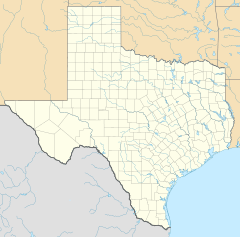Sisterdale, Texas facts for kids
Quick facts for kids
Sisterdale, Texas
|
|
|---|---|
 |
|
| Country | United States |
| State | Texas |
| County | Kendall |
| Elevation | 1,280 ft (390 m) |
| Time zone | UTC-6 (Central (CST)) |
| • Summer (DST) | UTC-5 (CDT) |
| ZIP code |
78006 (Boerne)
|
| Area code(s) | 830 |
| FIPS code | 48-68060 |
| GNIS feature ID | 1347179 |
Sisterdale is a small farming and ranching community in Kendall County, Texas. It was started in 1847 and is located about 13 miles north of Boerne. The community sits in the beautiful valley of Sister Creek.
Contents
History of Sisterdale
Sisterdale was founded in 1847 by a German surveyor named Nicolaus Zink. At first, it was part of Comal County. Later, in 1862, it became part of the new Kendall County.
Early Settlers and Important People
Many German pioneers settled in Sisterdale. These included Fritz and Betty Holekamp, and a geographer named Ernst Kapp. Other important people who lived here were a journalist named Carl Adolph Douai and August Siemering, who later started a big newspaper called the San Antonio Express News.
The first child born in Sisterdale was Julius Holekamp on June 10, 1849. He was the son of Fritz and Betty Holekamp.
One special early settler was Edward Degener. He later became a Republican congressman for Texas. Sadly, his sons, Hugo and Hilmar, died during the American Civil War. To remember them, Edward Degener and others bought land to build a monument called the Treue der Union Monument in 1866. This monument is now a historic place.
Another settler, Julius Dresel, was the first to plant a vineyard in Sisterdale. His brother Emil Dresel and a partner later started a famous vineyard in California.
Sisterdale got its own post office in 1851, and Ottomar W. Behr was the first postmaster. Over time, the community grew to have a school, a gas station, a general store, and a cotton gin. The old 1885 cotton gin has been fixed up and is now home to Sister Creek Vineyards.
Population Changes Over Time
The number of people living in Sisterdale has changed a lot over the years. Here's a quick look:
| Historical population | |||
|---|---|---|---|
| Census | Pop. | %± | |
| 1880 | 150 | — | |
| 1910 | 26 | — | |
| 1920 | 50 | 92.3% | |
| 1970 | 63 | — | |
| 1980 | 100 | 58.7% | |
| 1990 | 60 | −40.0% | |
| 2000 | 25 | −58.3% | |
| 2010 | 110 | 340.0% | |
Sisterdale's "Free Thinkers"
Sisterdale was one of the "Latin Settlements." These communities were started by people called "Forty-Eighters." They were German intellectuals who came to America after a series of revolutions in Germany in 1848.
These "free thinkers" believed in new ideas like freedom and equal rights for everyone. They loved talking about books, music, and philosophy. They even enjoyed speaking in Latin! They dreamed of a perfect society where everyone had basic human rights.
In 1853, these free thinkers asked the Texas Legislature for permission to open a German-English college in Sisterdale, but it didn't happen.
Irene Marschall King, whose grandfather visited Sisterdale, remembered how much he enjoyed the smart conversations there. She said the air was often filled with music, singing, dancing, and a feeling of general Gemütlichkeit (a German word for coziness and friendliness).
In 1853, a group called Der Freie Verein (The Free Society) was formed. They were against slavery and wanted to make changes in society. They held a big meeting in San Antonio in 1854 and decided on several important ideas:
- Everyone should get equal pay for equal work.
- The President of the United States should be chosen directly by the people.
- The death penalty should be stopped.
- Slavery is wrong and should be ended.
- Schools and universities should be free and supported by the state, without religious influence.
- Church and state should be completely separate.
Sisterdale During the Civil War
When Texas joined the Confederacy during the American Civil War, the Confederate government saw the free thinkers of Sisterdale as a threat. Many German Texans in Kendall County did not want to fight in the war because they believed it was wrong. They were called conscientious objectors.
In 1862, 61 of these objectors tried to escape to Mexico. However, they were chased by Confederate soldiers. At the Nueces River, 34 of them were killed, and some were executed after being captured. To honor these German Texans, the Treue der Union Monument ("Loyalty to the Union") was built in Kendall County in 1866.
Sisterdale Valley Historic District
|
Sisterdale Valley District
|
|

Sisterdale Bed and Breakfast
|
|
| Location | FM 1376, Sisterdale, Texas |
|---|---|
| Area | 2,893 acres (1,171 ha) |
| NRHP reference No. | 75001996 |
| Added to NRHP | January 8, 1975 |
The Sisterdale Valley District is a large historic area in Sisterdale, Texas. It was added to the U.S. National Register of Historic Places in 1975. This district covers about 2,893 acres and includes 15 important old buildings and six other structures. One of the historic buildings is a dance hall from the 1890s.
Images for kids










